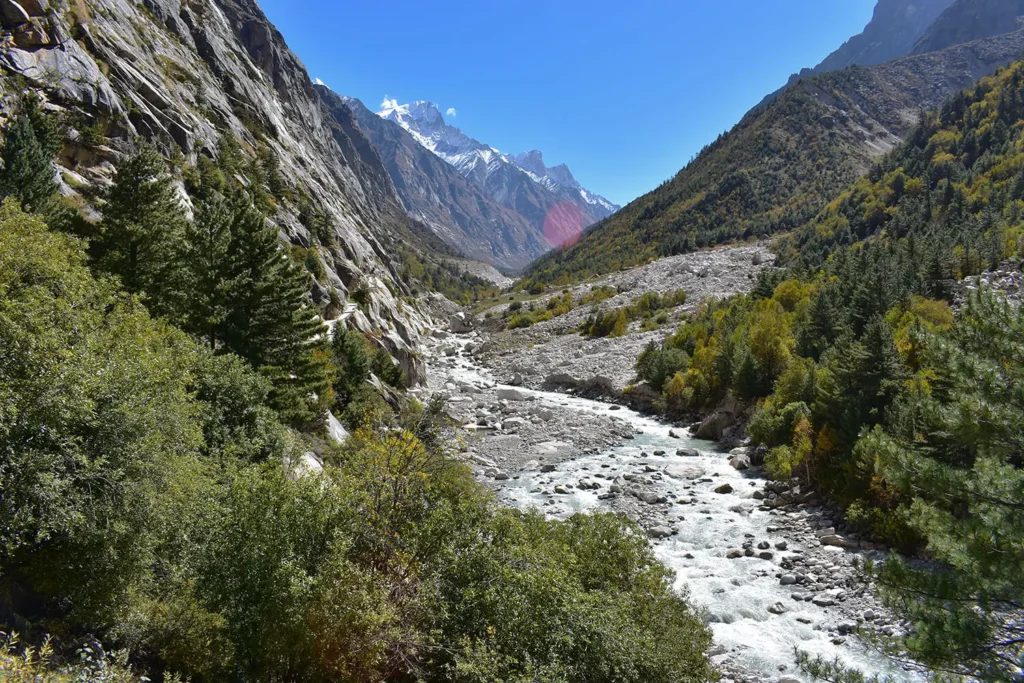Gaumukh Tapovan Trek‘s temperature varies throughout the year. Gaumukh experiences warm summer weather from May to June when the trekking trail opens. The peak summer seasons witness pleasant weather and mild temperatures. While days are longer with clear sunny days, nighttime will be cold. Gaumukh Tapovan temperature drops to subzero at night.
Autumn months of September to October also feature moderate temperatures and comfortable weather conditions. Harsh and extreme weather conditions make monsoon and winter months a big no for exploring Gaumukh Tapovan.
Before you plan your visit to the Gaumukh Tapovan, let’s know more about the detailed weather forecast and temperature in Gaumukh. We have compiled a month-wise Gaumukh temperature to help you plan your trek.
Gaumukh Tapovan Monthly Temperature Details
| Season | Month | Minimum Temperature | Maximum Temperature |
| Winter | January | -9°C | 8°C |
| Winter | February | -7°C | 10°C |
| Spring | March | -5°C | 12°C |
| Spring | April | -3°C | 14°C |
| Summer | May | -3°C | 18°C |
| Summer | June | 0°C | 20°C |
| Monsoon | July | 5°C | 22°C |
| Monsoon | August | 6°C | 23°C |
| Autumn | September | -3°C | 17°C |
| Autumn | October | -3°C | 15°C |
| Autumn | November | -5°C | 13°C |
| Winter | December | -7°C | 9°C |
Gaumukh – Tapovan Weather in Summer (May to June)

Gaumukh Tapovan Trek registers an average daytime temperature of around 20 °C during the peak summer seasons. Summer begins in May and continues till June end. Gaumukh Tapovan is a challenging trek suitable for experienced trekkers. The harsh and cold temperatures at higher altitudes are one of the characteristics the trekkers deal with in Gaumukh Tapovan.
Gaumukh Tapovan Temperature in May
May temperature ranges between -3°C to 18°C. If you are trekking to Gaumukh Tapovan, remember to be equipped with warm trekking clothes that withstand the freezing temperatures at the windy campsites.
Gaumukh Tapovan Temperature in June
The mercury level dips below freezing point at night. June registers the temperature between 0°C to 20°C in Gaumukh Tapovan. Days will be warm when the weather is clear. Extended daylight hours bless June with pleasant weather during the day. The night temperature further drops, increasing cold at higher altitudes.
Gaumukh Tapovan Weather in Autumn (Mid-September to Early November)

Embarking on the Gaumukh Tapovan trail in autumn is discovering the magical mountain views and spell-binding landscapes with comfortable day temperatures. Icy cold temperatures at night accompany the exotic autumn views.
The exotic autumn views are accompanied by comfortable day temperatures, making trekking a pleasant experience. However, it is essential to note that the temperatures drop drastically at night, making it extremely cold. So, carry warm clothing and gear to enjoy the trek wholeheartedly. Overall, the autumn season is a great time to visit Gaumukh Tapovan and experience the breathtaking beauty of the Himalayas.
Gaumukh Tapovan Temperature in September
Gaumukh temperature in September hovers around a maximum of 17°C and can drop to below-freezing points. The higher campsites at Tapovan register temperatures between 0°C to -3°C. September will have enough daylight and a constant supply of sunshine. The weather remains clear as the monsoons clear haze off the trail. Come prepared with enough layers to guard yourself from the biting cold of night. Gaumukh Tapovan Temperature in October
Gaumukh Tapovan temperature ranges between -5°C to 15°C in October. You will have slightly warm days but cold at night. The campsites will be windy, and the temperature further drop at higher elevations. Come with enough layers to keep yourself warm, especially at the higher campsites.
Gaumukh Tapovan Weather in Winter (December to February)
The biting chill sweeps the higher campsites of Gaumukh Tapovan. Constant snowfall causes the mercury level to dip. Winter temperatures in Gaumukh Tapovan are harsh and extreme. The weather conditions make it difficult to trek in Gaumukh. Due to heavy and extreme snowfall, it is not feasible to trek to Gaumukh during the winter season.
Expect the temperature to drop to as low as -5°C in December. Gaumukh registers a minimum temperature of -7°C. The icy, severe chill begins to spread across the trail.
January registers temperature between -9°C to 8°C in Gaumukh Tapovan. The chill and the fresh spell of snow drag down the mercury level.
In February, a fresh spell of severe cold grips the Gaumukh Tapovan trail. February witnesses temperatures between -7°C to 10°C in Gaumukh.
Gaumukh Tapovan Highlights
Gaumukh Tapovan Trek takes you closer to the gigantic glacier of Gaumukh, one of the largest glaciers in the Himalayas. The Gaumukh Glacier spreads around 30 km in length and is 4 km wide. The snout of Gaumukh is as gigantic as the glacier. To witness a glacier this big from a close distance is a rare experience.
Gaumukh Tapovan trek rewards you with the grandeur of Mt. Shivling. Along with Mt. Shivling, the trek offers clear views of Mt. Meru and the Bhagirathi sisters.
The trail takes you to Gaumukh glacier, where Bhagirathi originates and later becomes the holy river of Ganga. Tapovan is an occasional home to hermits seeking spiritual awakening.
Gangotri temple is another spiritual stop on this trek. The history of Gangotri dates back to the 18th century. The locals will share their exciting anecdotes from Mahabharata when you visit the Pandava Gufaa. Pandavas are believed to have taken rest at this place during their journey. It’s definitely worth exploring if you’re interested in ancient mythology and history!
The Gaumukh Tapovan trek is moderately challenging. Beginners can also attempt the trek with a fair amount of preparedness. The trek covers around 46 km and scales a maximum altitude of 15748 ft. As you trudge through Gaumukh, you will be amazed by the unforgettable amalgamation of history, spirituality, and awe-inspiring scenery.
Stunning backdrops, iconic sunrises and sunsets entice trekkers to embark on Gaumukh Tapovan trek. The trek starts and ends at the holy town of Gangotri.





